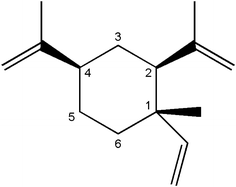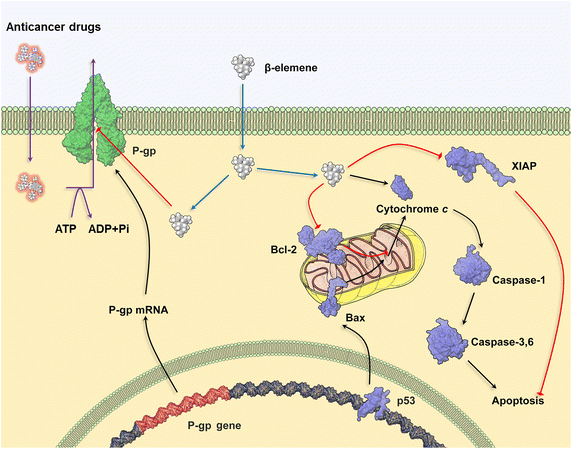The reversal of antineoplastic drug resistance in cancer cells by β-elemene
- PMID: 26370907
- PMCID: PMC4593349
- DOI: 10.1186/s40880-015-0048-0
The reversal of antineoplastic drug resistance in cancer cells by β-elemene
Abstract
Multidrug resistance (MDR), defined as the resistance of cancer cells to compounds with diverse structures and mechanisms of actions, significantly limits the efficacy of antitumor drugs. A major mechanism that mediates MDR in cancer is the overexpression of adenosine triphosphate (ATP)-binding cassette transporters. These transporters bind to their respective substrates and catalyze their efflux from cancer cells, thereby lowering the intracellular concentrations of the substrates and thus attenuating or even abolishing their efficacy. In addition, cancer cells can become resistant to drugs via mechanisms that attenuate apoptosis and cell cycle arrest such as alterations in the p53, check point kinase, nuclear factor kappa B, and the p38 mitogen-activated protein kinase pathway. In this review, we discuss the mechanisms by which β-elemene, a compound extracted from Rhizoma zedoariae that has clinical antitumor efficacy, overcomes drug resistance in cancer.
Figures


Similar articles
-
β-Elemene, a compound derived from Rhizoma zedoariae, reverses multidrug resistance mediated by the ABCB1 transporter.Oncol Rep. 2014 Feb;31(2):858-66. doi: 10.3892/or.2013.2870. Epub 2013 Nov 27. Oncol Rep. 2014. PMID: 24284783
-
Effect of β-elemene on the kinetics of intracellular transport of d-luciferin potassium salt (ABC substrate) in doxorubicin-resistant breast cancer cells and the associated molecular mechanism.Eur J Pharm Sci. 2018 Jul 30;120:20-29. doi: 10.1016/j.ejps.2018.04.037. Epub 2018 Apr 25. Eur J Pharm Sci. 2018. PMID: 29704644
-
Reversion of multidrug resistance in a chemoresistant human breast cancer cell line by β-elemene.Pharmacology. 2012;89(5-6):303-12. doi: 10.1159/000337178. Pharmacology. 2012. PMID: 22573000
-
Improvement of conventional anti-cancer drugs as new tools against multidrug resistant tumors.Drug Resist Updat. 2020 May;50:100682. doi: 10.1016/j.drup.2020.100682. Epub 2020 Feb 7. Drug Resist Updat. 2020. PMID: 32087558
-
Multidrug resistance: retrospect and prospects in anti-cancer drug treatment.Curr Med Chem. 2006;13(16):1859-76. doi: 10.2174/092986706777585077. Curr Med Chem. 2006. PMID: 16842198 Review.
Cited by
-
Efficacy and safety of elemene combined with chemotherapy in advanced gastric cancer: A Meta-analysis.Medicine (Baltimore). 2020 Mar;99(11):e19481. doi: 10.1097/MD.0000000000019481. Medicine (Baltimore). 2020. PMID: 32176081 Free PMC article.
-
Research Progress and Prospects of Autophagy in the Mechanism of Multidrug Resistance in Tumors.J Oncol. 2022 Jan 30;2022:7032614. doi: 10.1155/2022/7032614. eCollection 2022. J Oncol. 2022. PMID: 35136409 Free PMC article. Review.
-
Pharmacological Potential of Phylogenetically Diverse Actinobacteria Isolated from Deep-Sea Coral Ecosystems of the Submarine Avilés Canyon in the Cantabrian Sea.Microb Ecol. 2017 Feb;73(2):338-352. doi: 10.1007/s00248-016-0845-2. Epub 2016 Sep 10. Microb Ecol. 2017. PMID: 27614749
-
Asymmetric total synthesis of (1S,2S,4S)-β-elemene.RSC Adv. 2022 Mar 15;12(13):8249-8255. doi: 10.1039/d2ra01408d. eCollection 2022 Mar 8. RSC Adv. 2022. PMID: 35424753 Free PMC article.
-
Comparative efficacy of whole-brain radiotherapy with and without elemene liposomes in patients with multiple brain metastases from non-small-cell lung carcinoma.Curr Oncol. 2016 Aug;23(4):e377-82. doi: 10.3747/co.23.3183. Epub 2016 Aug 12. Curr Oncol. 2016. PMID: 27536187 Free PMC article.
References
Publication types
MeSH terms
Substances
Grants and funding
LinkOut - more resources
Full Text Sources
Other Literature Sources
Research Materials
Miscellaneous

